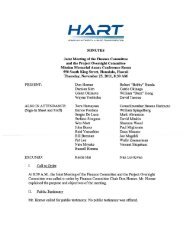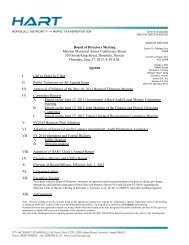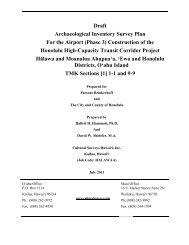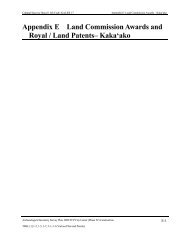4.12 Test Excavation 167 (T-167) - Honolulu Rail Transit Project
4.12 Test Excavation 167 (T-167) - Honolulu Rail Transit Project
4.12 Test Excavation 167 (T-167) - Honolulu Rail Transit Project
You also want an ePaper? Increase the reach of your titles
YUMPU automatically turns print PDFs into web optimized ePapers that Google loves.
Cultural Surveys Hawai‘i Job Code: KALIHI 23 Kewalo <strong>Test</strong> <strong>Excavation</strong>s 162 – 178Boulevard, located approximately 175.0 m northeast of T-173. No cultural resources wereencountered (O’Leary and Hammatt 2006). In 2010, CSH conducted archaeological monitoringfor a Traffic Signal <strong>Project</strong> around the intersection of Queen Street and Kamake‘e Street, whichwas located approximately 50.0 m southeast of T-173. Portions of a truncated buried A-horizonoverlying Jaucas sand were documented, and no cultural resources were encountered (Yamauchiet al. 2011).Documentation Limiatations: T-173 was excavated to the water table at a depth of 1.37 mbs.There were no factors limiting documentation.Stratigraphic Summary: The stratigraphy of T-173 consisted of fill strata overlying naturalsediment to the water table. Observed strata included asphalt (Ia), very gravelly sandy loam basecourse (Ib), very gravelly loam fill (Ic), very gravelly sand fill (Id), very gravelly sandy loam fill(Ie), gravelly fine to coarse sand fill (If), and silty clay fill (Ig), overlying a natural loamy sandburied A-horizon (II) and naturaly medium-grain sandy loam (III) to the water table. Observedstratigraphy generally conformed to the USDA soil survey designation of Fill land (FL).Artifacts Discussion: No artifacts were encountered.Features Discussion: No features were observed.Terrestrial Faunal Remains Collected During <strong>Excavation</strong>: No terrestrial faunal remains werecollected individually during excavation.Sample Results: No samples were collected.GPR Discussion: A review of amplitude slice maps indicated no linear features which mightindicate the presence of utilities. Reflectivity was relatively uniform throughout the grid anddecreases with depth. A transition from higher reflectivity to lower reflectivity was observed atapproximately 0.25 mbs and increases again around 0.75 mbs.GPR depth profiles for T-173 identified horizontal banding, commonly associated withstratigraphic layering, throughout the survey area. This banding corresponded to variations ofdensity and chemical composition within fill deposits. The profile also indicated a change inreflectivity occurring around 0.25 mbs and again at 0.5mbs. No utilities were observed in theprofile. The maximum depth of clean signal return was approximately 1.0 mbs.Summary: T-173 was excavated to the water table at a depth of 1.37 mbs. The stratigraphy of T-173 consisted of fill strata (IA-Ig) overlying natural sediment (II-III) to the water table. Observedstratigraphy generally conformed to the USDA soil survey designation of Fill land (FL). Nocultural resources were identified within T-173.HHCTCP City Center (Section 4) AIS Report, Vol. IV C 836TMK: [1] 1-2, 1-5, 1-7, 2-1, 2-3 (Various Plats and Parcels)
















